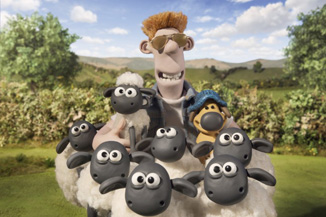Movie Review: Shaun the Sheep
By Ben Gruchow
August 12, 2015
BoxOfficeProphets.com

The next praise to illustrate drives the whole review, which is that even being utterly befuddled by the minutiae of a densely-interconnected story would in no way diminish my absolute enjoyment of the film. This is a sweet-natured, very funny film that’s also surprisingly mature and moving. It also serves as a calm respite from the tendency of family films to be talky, noisy, and over-plotted: there is hardly anything more complex on the surface here than the story of what happens when a flock of sheep decide they want a vacation from the daily routine on their farm. There’s no spoken dialogue in the movie; the only instances of the English language show up as snippets from songs, played mostly diegetically. This is not to say, though, that there is no communication: Every character, human or animal, clearly illustrates thought and intent through a litany of precisely-tuned expressions, body language, and a broken series of grunts and growls that, I imagine, convey emotions the same way in any language.
The world of Shaun the Sheep is made up of three locations: Mossy Bottom, a bucolic image of a Dutch farm; the Big City, which seems to consist mostly of back alleys and trash piles with gleaming skyscrapers serving as a constant backdrop; and the long and winding road connecting the two. The primary mode of action in this world appears to be comedic escalation - piling complication on top of complication until everything is unraveling in a sort of joyful chaos. With this in mind, it’s only right that Shaun’s plan to take a vacation goes awry enough times for the farmer to end up in a tiny camper that’s rolling uncontrollably down the road to the Big City; once there, he gets knocked on the head and wakes up in the hospital with memory loss.
Shaun and the other sheep venture into the city in an attempt to locate him, and they’re waylaid by…well, everything. There is what I guess you could call an antagonist, but the term seems unnecessarily harsh up until the final minutes of the story. Instead, most of the middle hour of Shaun the Sheep Movie consists of Shaun and friends trying desperately to evade detection, and usually failing, with often-amusing results; an elaborate sequence in a restaurant provides some opportunity to lightly satirize a culture obsessed with imitating celebrity, while also giving us some of the movie’s biggest laughs; a runner-up for the prize is an extended meet-and-greet with the residents of a unique type of jail - with what has to be the most off-the-cuff nod to Anthony Hopkins’ Hannibal Lecter in a long time, if ever. But these comic set pieces (and there are a great many more) are bookended and reside within the larger fabric of a simple and affectionate little tale about home and companionship.
Directors Richard Starzak and Mark Burton augment this slight and compact story with attractive and convincing animation set against an environment jaw-dropping in its detail and inventiveness. The world of Shaun the Sheep is rendered to the fullest degree I think possible; this is possibly due in part to its setting in something more or less like the real world, but the little touches and textures on everything are so complete that we have to constantly remind ourselves that everything on-screen was created for it; nothing has been ported in from the real world. There are lots of little bits of comic material in the background, and much of it wouldn’t be as noticeable or wouldn’t land if not for the persuasiveness of the movie’s world. This is the type of world that CGI, for all of its strengths, still cannot create. Starzak and Burton also use the tactile reality of the sets and characters (I love the evident fingerprints on the faces and bodies of the cast; it adds another unexpected touch of warmth) to light and stage scenes in gorgeous and exciting ways.
Movies like this and Fury Road reinforce the sense that the great stories and characters can easily function independently of any larger overall plot; there can certainly be a bigger canvas or a bigger whole, but the reason the great stories grab you is because everything they need is right there, available to be heard, seen, and deeply felt - whether it’s exhilaration you feel, affection, or even the sense of time well spent with likable and textured characters, you feel it deepest with these. I can’t say with certainty how long it’ll be before I make my way over to Aardman’s other work - which, as I understand, is just as good - but there’s no denying the successful marriage of craft to intelligence and warmth on display here. The right word for Shaun the Sheep Movie, I think, is “delightful.”